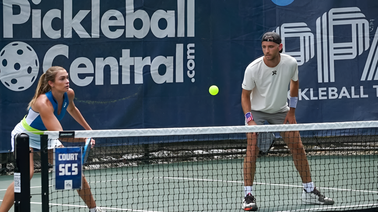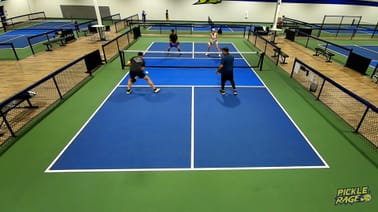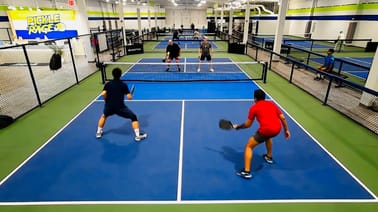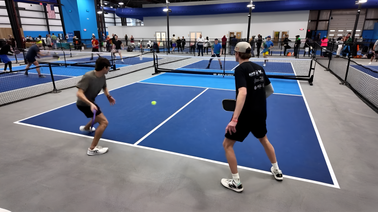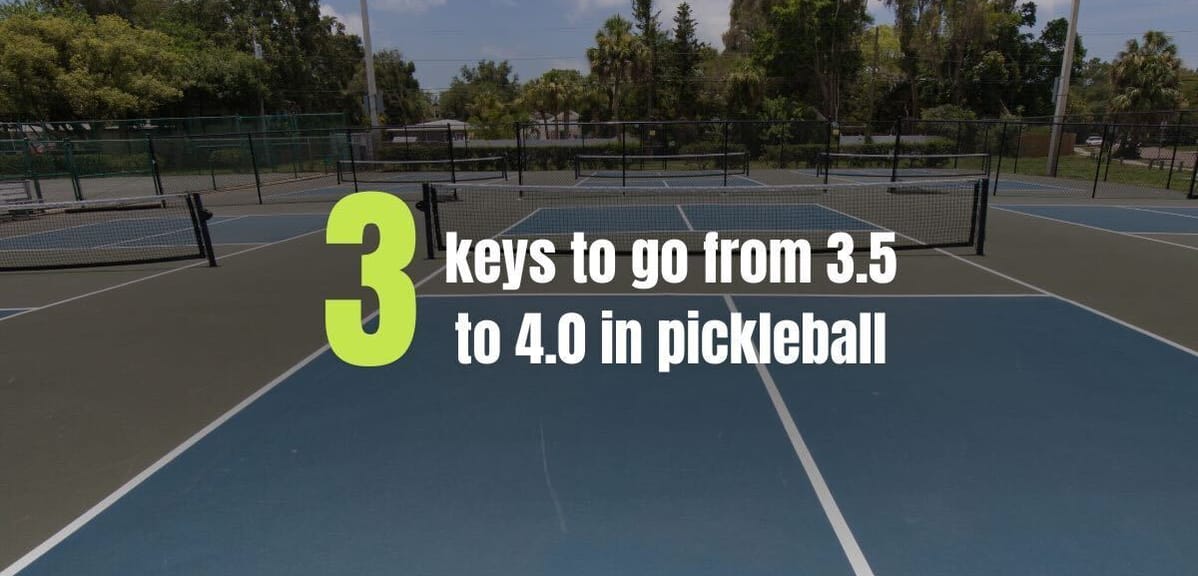
The first year of your pickleball journey is arguably the most exciting. Few moments rival playing those first few games, learning how to drill, and starting to play more competitively.
At the 3.5 level, you’re no longer a beginner, but you start to realize just how much there is left to learn.
At this earlier stage, the easiest way to develop as a player is to play as much as possible.
If you are looking for more specific things to work on, here are my three keys to help you grow from a 3.5 to a 4.0 player.
Am I a 3.5 pickleball player?
First, it may be helpful to identify (or approximate) your current rating. To see a detailed breakdown of each skill rating, check out the USA Pickleball player skill rating definitions. Learn more about rating yourself here.
A 3.5 player is still learning how to hit a backhand and is able to hit a forehand with moderate control. They hit most serves and returns in play, but lack the ability to control depth.
A 3.5 can sustain medium length dink rallies, struggling to control the height and depth. They can hit a safe third shot drop that allows them to get to the net and volley with a medium level of pace.
Not at this point in your game development yet? Read: 7 Things You Should do to go from a 3.0 to 3.5 Pickleball Player
From a strategic standpoint, 3.5s understand the importance of getting to the kitchen, and do so when the opportunity arises. They understand the importance of hitting softly versus with power, and are still learning proper court positioning.
(p.s 3/7/2025 we just landed a deal with Midwest Racquet Sports who we believe has the best selection pickleball shoes on the market. Use code "THEDINK" to save 10%)
Things to Focus On
- Develop the Dink
Odds are, the majority of the people you play with can drive the ball and do it often. This is a good shot to have, especially at the lower levels.
But to quickly work your way up the pickleball ratings ladder, you have to develop the softer shots at the Kitchen, especially the dink:
- Start by keeping your wrist firm and extending your arm
Keep your technique simple. Don’t use too much wrist, and think of the paddle as an extension of your arm. Keep the paddle face slightly facing up, and lightly bump the ball over the net and land it in the kitchen in front of your opponent.
Hit flat dinks until you can do it without missing – you will start to add spin at the next level.
- Dink primarily cross court
If you watch higher-level pickleball, you will notice the players hitting on average 75-85 percent of their dinks cross court.
This is the safer and smarter play, as it gives you a higher margin for error on your dink without getting attacked. Practice dinking cross court and use the down-the-line dink as a mix up or to target weaker opponents.
- Practice good footwork
When dinking, keep your feet shoulder-width apart and stay in an athletic stance with your knees slightly bent. When you have to move side-to-side, don’t cross your feet, but stay with them apart and crab walk.
This will keep you ready for any form of attack and will allow you to move more fluidly along the Kitchen line.
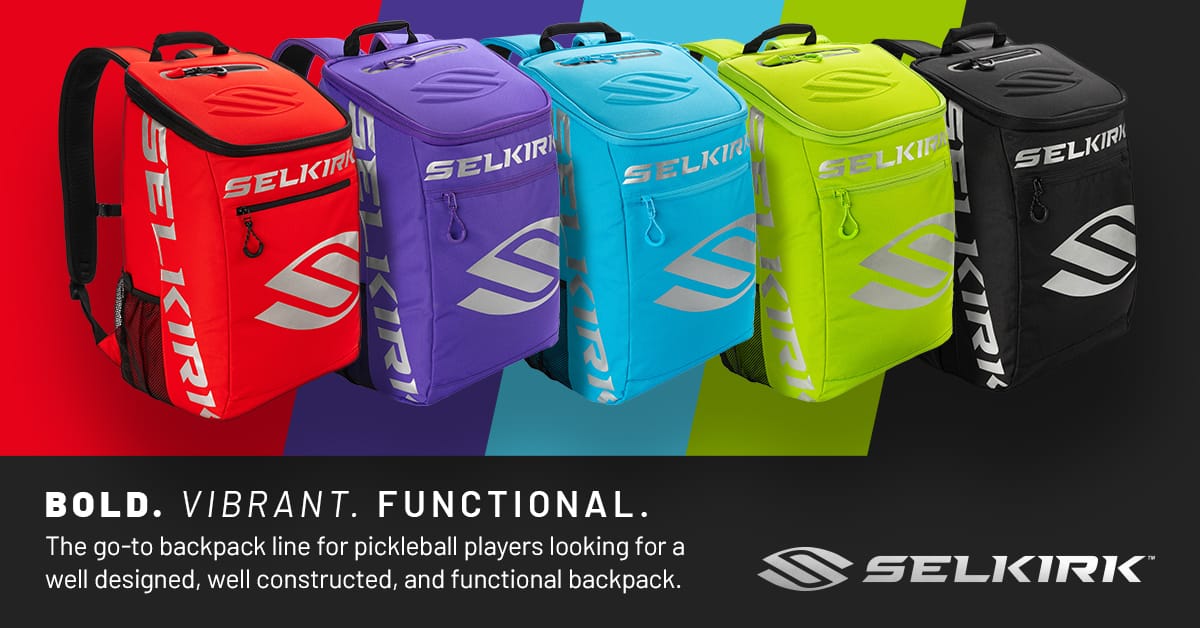
Things to Avoid
- Taking too big of a swing
Less is more in pickleball, especially when it comes to your backswing. Try to keep your paddle in front of you, especially when dinking.
Here’s a fool-proof tip: can you see the ball and your paddle at the same time? If not, shorten your swing and exaggerate keeping the paddle more in front.
- Don’t forget to attack when given the chance
As you learn to sustain medium to longer dink rallies, don’t get lulled into too defensive of a mindset.
Remember, the point of dinking is to set up the speed up. Once your opponent pops one up, be ready to take it out of the air and attack down the line or to the middle.
- Watch the height and depth of your dinks
The perfect dink stays relatively low as it crosses the net, and lands right at your opponents’ feet, near their Kitchen line.
Too high of a dink, and they can attack you out of the air. Too low, and it goes in the net and the point is over.
Pretend there is a window above the net that is 5-9 inches in height and try to hit it through that window.
Recommended Drill: Dink games to 7 at the kitchen
Get with your partner and have them line up diagonally. Play a game to seven, with both players at the Kitchen.
Start with dinking only (no attacking), and then play a game with attacking allowed.
Just make sure you are attacking to the middle of the court and not cross court.
Play this for both forehand and backhand cross-court dinks and then down both lines too.
Bonus tips
- Lunges and Squats are your new best friends
If you truly want to master dinking, you have to build strength in your lower back and legs.
Using your body weight to start, do some basic lunges, squats and superman back flexes each day to help strengthen your core and legs. This will help you stay in the athletic position and have more stamina during longer rallies.
Start by doing sets of 10, and do as many sets without going overboard. With consistency, you will start to notice more strength, which will lead to better dinks and overall play. Add low-weight dumbbells to continue to build strength.
- The Wall: your new drilling partner
While drilling with a partner or a group is definitely more fun, drilling against the wall can be just as beneficial. Find a flat, solid wall and visualize the approximate height of a pickleball net.
Work through the tips mentioned above, and practice consistently hitting solid dinks just over the net. Make sure you are standing at least seven feet back to simulate the size of the Kitchen.
The Wall never misses, and it can provide the perfect practice partner if you are playing solo or just looking to warm up before playing matches or recreationally.
Be sure to subscribe to get our weekly pickleball tips in your inbox for free every week. Enjoy the grind, and remember, you can’t dink all day if you don’t start in the morning.
p.s this is still one of our top viewed articles of all time. If your curious about our most viewed story in 2025, check out this high tech pickleball here.

Eric Roddy
Eric is a PPA tour pro living in Charlotte, NC, sponsored by PROXR. In addition to playing PPA events, he teaches pickleball 2-3 hours a week, enjoys golf, and listening to his favorite band Goose.


